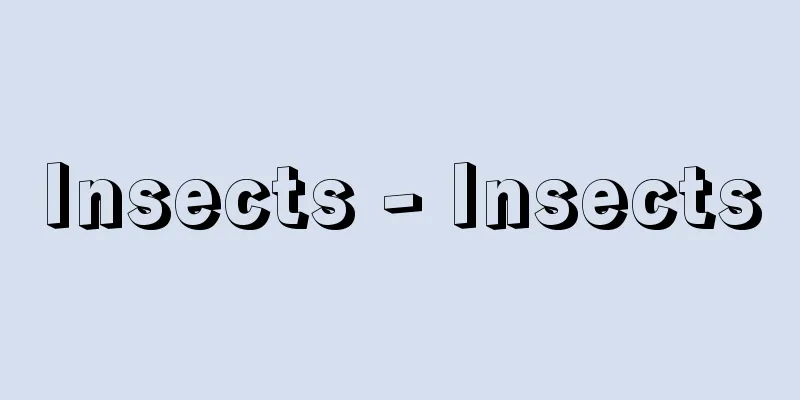Polychaete - Polychaete

|
A group of animals that make up the class Polychaeta in the phylum Annelida. It is the largest and most basic group of annelids. Some of the Polychaeta evolved into freshwater and land to become oligochaetes (earthworms), and it is believed that some of the oligochaetes evolved into leeches, which have 34 segments. The body of polychaetes is divided into many segments, each of which has a warty foot with several to several dozen setae growing from it, hence the name. Most polychaetes are marine, and their lifestyles are diverse; some live under stones, at the base of seaweed, or in tubes they create in sand or mud, while others drift in the ocean as plankton their whole lives. Most species are 2 to 20 centimeters in length, but small ones are only about 5 millimeters long, and the largest, the Uncidae family, can reach over 1 meter in length. Currently, there are approximately 6,000 known species in the world, and approximately 800 in Japan. [Minoru Imajima] formThe head has tentacles, paratentacles, and eyes, but their shapes vary depending on the species, and their functions also differ significantly. Some have a body segment that is almost the same shape continuing from the head to the torso to the extremities of the body, while others have a body segment that is divided into two parts, the thorax and the abdomen, each of which has a different shape. The former are classified as free-ranging and the latter as sedentary, and most sedentary creatures live in tubes that they have created. The shape of the peduncle also varies depending on the species, but all have a bundle of chitinous setae that they extend and retract from the peduncle to help them move. Some species have gills on the peduncle that help exchange oxygen and carbon dioxide, but peduncles without gills have a network of capillaries. Blood that moves from the dorsal vessels to the lateral vessels picks up oxygen as it passes through the capillaries in the body wall and the peduncle and enters the ventral vessels. Blood flows forward in the dorsal vessels and backward in the ventral vessels. Blood is red because it contains hemoglobin, but some types contain chlorocruorin, which makes the blood green. [Minoru Imajima] Physiology and ecologyThe digestive tract runs vertically down the center of the body, through the mouth, pharynx, esophagus, intestines and anus. The type of food they eat varies depending on the structure of their mouths and the appendages in their heads; some are carnivorous, some eat mud and digest and absorb the organic matter in it, and some catch plankton. Some lugworms and earthworms have large sickle-shaped teeth that they use to grip food and swallow it whole. Many scale worms form symbiotic relationships, living on the surface of sponges, sea urchins and starfish. Some species glow, and the penetrating lugworm and the planktonic Odontosyllis are well-known examples, but it has recently been reported that a species of the Odontosyllis genus in the Siliciidae family glows on the coast of Uozu in Toyama Bay. [Minoru Imajima] ReproductionGenerally, they are dioecious, but there is little difference in their appearance. However, in the case of lugworms and worms, when it is time to reproduce, their body shape changes to a reproductive form that is convenient for swimming in the water, and the female and male release eggs or sperm as they swim, and fertilization occurs. This reproductive form is called bachi or parolo. There are also species such as the black worm and the burrowing worm that protect their eggs in gelatinous sacs and lay them on sand, mud, or seaweed. On the other hand, asexual reproduction also occurs, in which new individuals are produced from the body and eventually leave the parents. [Minoru Imajima] useAbout 20 kinds of polychaetes, including worms and sea worms, have long been used as fishing bait. In recent years, due to the rapid increase in the number of anglers, they are imported from Korea, China, the Philippines, and other countries, and sea worm farming is actively carried out in Kochi and Ehime prefectures. [Minoru Imajima] ©Tomita Hyakushu "> Main species of worms (1) [specimen illustrations] ©Tomita Hyakushu "> Main species of worms (2) [specimen illustrations] ©Tomita Hyakushu "> Main types of isome (specimen illustrations) It stores its body in a long, thin tube that is filled with shell fragments and seaweed. © Underwater Fort Enterprise, Isamu Soyama "> Amazing worm (ecology) When stimulated, the glandular cells secrete luminous mucus. © Underwater Fort Enterprise, Isamu Soyama "> Bioluminescence of the Penguin Worm (Ecology) Source: Shogakukan Encyclopedia Nipponica About Encyclopedia Nipponica Information | Legend |
|
環形動物門の1綱Polychaetaを構成する動物群。環形動物のなかでもっとも大きい基本群である。多毛類の一部が淡水中や陸上にあがって貧毛類(ミミズ)となり、貧毛類のうち、あるものが34体節をもったヒル類になったと考えられている。 多毛類の体は多くの体節に分かれ、おのおのの節にはいぼ足があり、これに数本から数十本の剛毛が生えているところからこの名がある。多毛類は大部分が海産で、石の下、海藻の根元、砂や泥の中に管をつくってその中で生活するもの、また一生プランクトンとして海中を漂っているものなど生活様式は多様である。大部分の種類は体長が2~20センチメートルであるが、小形のものでは5ミリメートルぐらい、大きなものではイソメ科の1メートル以上に達するものもある。現在、世界では約6000種、日本では約800種が知られている。 [今島 実] 形態頭部には感触手、副感触手、目があるが種類によって形も異なり、またその機能にも著しい差異がみられる。頭部から胴部が続き、体の末端までほぼ同じ形の体節が連続しているものと、胴が胸部と腹部の二つに分かれ、それぞれ異なった形の体節からなっているものがある。前者を遊在類、後者を定在類と区別しており、定在類の大部分は管をつくってその中で生活している。いぼ足の形も種類によってさまざまであるが、いずれもキチン質の剛毛束をもち、これをいぼ足から出したり引っ込めたりして移動する際に役だてる。また、ある種類では、いぼ足にえらがあって酸素や二酸化炭素の交換を助けているが、えらをもたないいぼ足では、毛細血管が網の目のように張り巡らされている。背行血管から側血管に移った血液は体壁やいぼ足の毛細血管を通るときに酸素を取り入れ腹行血管に入る。血液は背行血管では前方に、腹行血管では後方に流れる。血液にはヘモグロビンが含まれているので赤い色をしているが、種類によってはクロロクルオリンを含んで緑色をしているものもある。 [今島 実] 生理・生態消化管は口、咽頭(いんとう)、食道、腸、肛門(こうもん)と体の真ん中を縦に通っている。口の構造と頭部の付属器官によって食物の種類が違っていて、肉食のもの、泥を食べてその中の有機物を消化吸収するもの、プランクトンをとらえるものなどがあり、ゴカイやイソメの類では大きな鎌(かま)形の歯があって、これで食物を挟んでまる飲みにする。ウロコムシ類では共生するものが多く、カイメン、ウニ、ヒトデの体表で生活している。発光する種類があり、ツバサゴカイや浮遊性のオヨギゴカイはよく知られた例であるが、最近シリス科のOdontosyllis属の種類が富山湾魚津(うおづ)の海岸で発光することが報告された。 [今島 実] 生殖一般に雌雄異体であるが、外形的な差はほとんどみられない。しかし、ゴカイやイソメの類は生殖の時期になると体形が変化して水中を泳ぐのに都合のよい生殖型になり、雌と雄がそれぞれ泳ぎながら卵あるいは精子を放出し、受精が行われる。バチとかパロロというのはこの生殖型をいう。また、クロムシやギボシイソメのように、ゼラチン質の袋の中に卵を保護して砂泥上や海藻に産み付けるものもある。一方、体から新しい個体を生じ、やがては親から離れていく無性生殖も行われる。 [今島 実] 利用多毛類のうちのゴカイ類、イソメ類など約20種類ほどは、魚の釣り餌(え)として古くから利用されている。近年、釣り人口の急増のため、韓国、中国、フィリピンなどから輸入するほか、高知県や愛媛県ではイソゴカイの養殖が盛んに行われている。 [今島 実] ©冨田百秋"> ゴカイ類のおもな種類(1)〔標本画〕 ©冨田百秋"> ゴカイ類のおもな種類(2)〔標本画〕 ©冨田百秋"> イソメのおもな種類〔標本画〕 貝殻の破片や海藻をつけた細長い棲管に体を納める©水中フォート・エンタープライズ 楚山いさむ"> スゴカイイソメ(生態) 刺激されると発光性の粘液を腺細胞から分泌する©水中フォート・エンタープライズ 楚山いさむ"> ツバサゴカイの発光(生態) 出典 小学館 日本大百科全書(ニッポニカ)日本大百科全書(ニッポニカ)について 情報 | 凡例 |
<<: Tamogitake (English name) Pleurotus cornucopiae
>>: Multiple cropping - tamousaku
Recommend
Abertybee - Abertybee
…Until 1974 it was the capital of the former coun...
FT NMR - FTNMR
…Instead of the previous sweep (continuously chan...
Sasa (bamboo grass)
A plant of the grass family with long woody culms....
Rabbit (Usagi) - Rabbit
A general term for the Lagomorpha and Leporidae. T...
Antimony nonachloride
...Three types are known: antimony(III) chloride,...
Hypnea charoides (English spelling) Hypneacharoides
…[Mitsuo Chihara]. . . *Some of the terminology t...
Shivaji - Shivaji (English spelling)
Founder of the Maratha Kingdom, a Hindu dynasty c...
Akiru Plateau
…In 1955, the three villages of Higashiakiru, Nis...
Scooter
...In English, the word scooter originally meant ...
Niya - Niya (English spelling)
The remains of an ancient settlement on the south...
Hallucination - genkaku
The definition of illusions and hallucinations in...
Unemegahara
A place name in Edo. It was named after the reside...
Familial amaurotic idiocy
This syndrome is a representative type of cerebral...
Scythian culture - Scythian culture
The culture of the Scythians, an Iranian horse-rid...
Acylcarnitines
A compound that is produced by binding with carnit...









